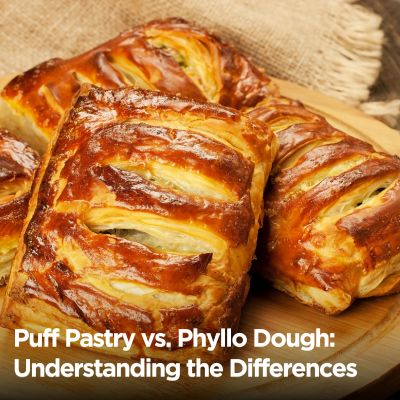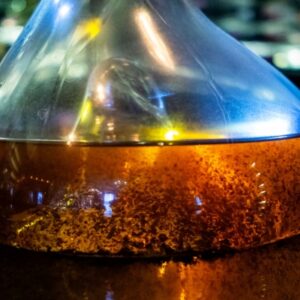When baking, the type of dough you use can significantly impact the final result. Puff pastry vs. phyllo dough is a common comparison because both are used in various sweet and savory dishes worldwide.
While they may look similar, their structure, texture, and preparation methods set them apart. Puff pastry is light and flaky with a rich, buttery taste, while phyllo dough is paper-thin and bakes into a crisp, delicate texture.
Staples in French, Middle Eastern, and Mediterranean cuisine, these doughs shape everything from elegant pastries to traditional savory dishes.
As the global frozen pastry market grows, reaching an estimated $2.42 billion in 2024, the demand for puff pastry and phyllo dough remains strong across various regions. This guide will explore their main characteristics and best uses so you can confidently pick the perfect dough for your next recipe.
What is Puff Pastry?
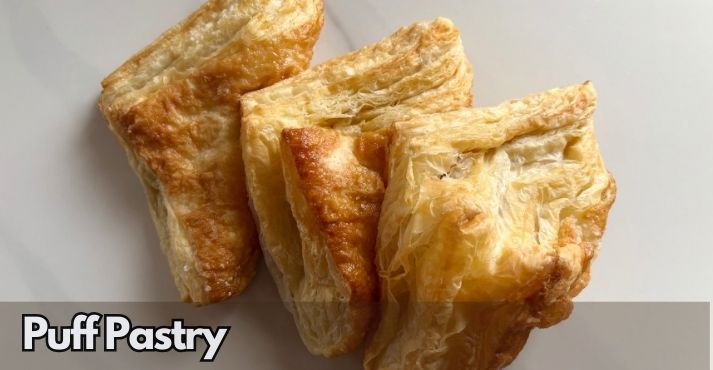
Puff pastry is a special type of laminated dough made by folding layers of butter between thin sheets of dough. This process creates its signature light, flaky texture when baked.
Puff pastry is a staple in European baking and plays a vital role in French cuisine. It forms the base for well-known treats like croissants, mille-feuille, and vol-au-vents.
Unlike phyllo dough, which is much thinner and requires layering with oil or butter before baking, puff pastry already contains butter within its layers. When heated, the butter releases steam, causing the dough to expand and form delicate, airy layers.
Its versatility makes it a go-to ingredient for sweet and savory dishes, from fruit-filled pastries to flaky cheese straws.
Ingredients and Preparation
Traditional puff pastry is made from four ingredients: flour, butter, water, and salt. Its texture comes from the lamination process, where the dough is repeatedly rolled out, layered with butter, and folded multiple times.
This creates hundreds of delicate layers that rise beautifully in the oven. Achieving perfect puff pastry requires patience, as the dough must be chilled between folds to keep the butter from melting into the dough. This careful preparation sets it apart from phyllo dough, which is rolled paper-thin and doesn’t rise similarly.
When enjoying puff pastry, visiting one of the many types of cafés that offer rich coffee varieties is a perfect way to enhance the experience. Whether at a casual café or a more upscale French-style bistro, pairing your pastry with freshly brewed coffee can make the flavors shine even more.
Texture and Characteristics
Puff pastry is known for its buttery, crisp, and flaky texture. Unlike many other doughs, it doesn’t use yeast or baking powder for leavening. Instead, the steam from the butter and water in the dough causes it to rise.
As the butter melts, moisture evaporates, pushing the dough layers apart and creating a golden, airy structure. Whether making savory tarts, pastries, or crispy appetizers, puff pastry offers a rich, melt-in-your-mouth experience, distinguishing it from phyllo dough’s thinner, crispier texture.
Understanding the difference between phyllo dough and puff pastry helps bakers choose the right dough for each recipe, ensuring the best results. These differences are often showcased at events like the Bakery and Pastry Trade Show, where experts present creative ways to use both doughs.
What is Phyllo Dough?
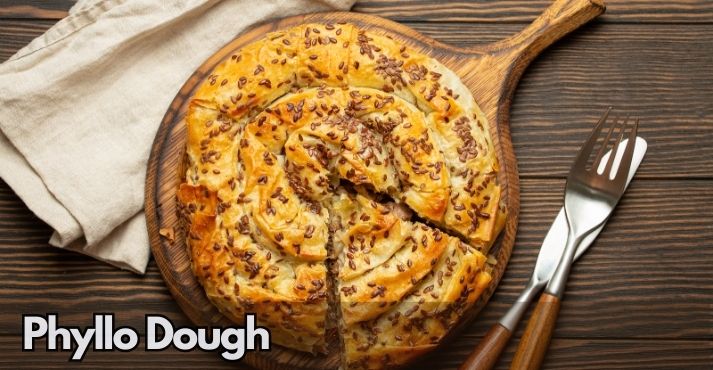
Phyllo dough is a thin, delicate pastry widely used in Mediterranean and Middle Eastern cuisines. Unlike puff pastry, which rises into airy layers when baked, phyllo dough remains crispy and paper-thin.
It serves as the base for well-known dishes like baklava and spanakopita, where multiple sheets are stacked, each brushed with butter or oil to form a golden, flaky crust.
Its light and crunchy texture makes it an excellent choice for sweet desserts and savory dishes, from honey-soaked pastries to cheesy, herb-filled pies.
Ingredients and Preparation
Phyllo dough is made with flour, water, and a small amount of oil or vinegar. Instead of folding layers like puff pastry, phyllo is rolled and stretched until nearly transparent.
In traditional baking, this process is done by hand, requiring skill and patience, but pre-made sheets are widely available for convenience. Since phyllo dries out quickly, keeping it covered while working with it is important to prevent cracking.
Texture and Characteristics
Once baked, phyllo dough becomes crisp, light, and flaky, adding a delicate crunch to any dish. Unlike puff pastry, which has butter folded into its layers, phyllo dough must be brushed with butter or oil between sheets to achieve the same rich, golden flakiness.
The result is a crispy, layered texture that works beautifully in savory and sweet recipes. Comparing phyllo dough and puff pastry helps bakers decide which one to use, depending on whether they want a buttery, puffy pastry or a delicate, crispy bite.
Differences Between Puff Pastry and Phyllo Dough
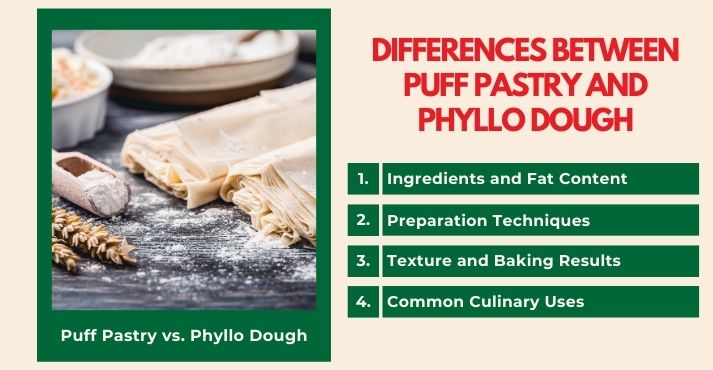
[fusion_table fusion_table_type=”1″ fusion_table_rows=”” fusion_table_columns=”” margin_top=”” margin_right=”” margin_bottom=”” margin_left=”” hide_on_mobile=”small-visibility,medium-visibility,large-visibility” class=”” id=”” animation_type=”” animation_direction=”left” animation_speed=”0.3″ animation_offset=””]
| Features | Puff Pastry | Phyllo Dough |
|---|---|---|
| Ingredients | Flour, butter, water, salt | Flour, water, small amount of oil/vinegar |
| Fat Content | High (butter folded into layers) | Minimal (fat added between layers) |
| Preparation | Laminated (folded and rolled) | Rolled into thin sheets |
| Texture | Flaky, airy, and rich | Thin, crisp, and delicate |
| Baking Process | Rises due to steam in layers | Stays flat and crunchy |
| Common Uses | Pies, tarts, turnovers, pastries | Baklava, spanakopita, savory pies |
[/fusion_table]
Puff pastry and phyllo dough are widely used in baking but differ in ingredients, preparation methods, and texture. Knowing the differences will help you choose the right one for your recipe.
1. Ingredients and Fat Content
The main difference between these two pastries is their fat content. Puff pastry has a high butter content, which gives it a rich, flaky texture. The butter is layered within the dough, helping it puff up when baked.
On the other hand, Phyllo dough contains little to no fat. It’s made with flour, water, and a small amount of oil or vinegar. Before baking, each sheet is brushed with butter or oil to create flakiness.
2. Preparation Techniques
Puff pastry is made using a lamination process, where layers of dough and butter are folded and rolled repeatedly. This method traps air and moisture, creating hundreds of delicate layers that expand when baked.
Phyllo dough, however, is rolled and stretched into paper-thin sheets rather than folded. Instead of relying on trapped air, multiple sheets are stacked, with butter or oil added between them, to create a crisp and flaky texture.
3. Texture and Baking Results
Because of their different preparation methods, puff pastry and phyllo dough are baked differently. Puff pastry rises in the oven, forming a light, buttery, and flaky texture with a slightly chewy bite.
Phyllo dough does not rise. Instead, it becomes crisp, thin, and brittle after baking. It’s ideal for layered, crunchy dishes like baklava and spanakopita.
4. Common Culinary Uses
Puff pastry is popular in European baking and is best for dishes that need a buttery, flaky crust. It’s commonly used for:
- Savory dishes: Pies, tarts, turnovers, and vol-au-vents
- Sweet treats: Napoleons, palmiers, and popular pastries like fruit-filled ones
Phyllo dough is a Mediterranean and Middle Eastern cuisine staple, often used for layered desserts and appetizers. It’s found in dishes such as:
- Sweet recipes: Baklava, galaktoboureko, and strudels
- Savory dishes: Spanakopita, börek, and samosas
Choosing between puff pastry or phyllo dough depends on the texture you want to achieve in your dish. Understanding the differences between both can help you make the best choice for your recipe.
Whether aiming for a buttery, flaky texture with puff pastry or a crisp, delicate crunch with phyllo dough, selecting the right dough ensures delicious results.
When to Use Puff Pastry vs. Phyllo Dough
Both puff pastry and phyllo dough are versatile, but choosing the right one depends on the texture, structure, and flavors you want in your dish.
Recipe Suitability
Puff pastry is ideal for recipes with a light, flaky, buttery texture. It works well for dishes that require a substantial, layered structure that holds its shape after baking. Common uses include:
- Savory dishes: Pot pies, turnovers, and Wellington
- Sweet treats: Danish pastries, mille-feuille, and fruit tarts
Phyllo dough is best for dishes with delicate, crisp layers, often stacked and brushed with butter or oil. It’s frequently used in recipes that involve layered fillings or syrup-soaked textures, such as:
- Sweet desserts: Baklava, galaktoboureko, and nut-filled pastries
- Savory dishes: Spanakopita, börek, and cheese-filled pies
For anyone passionate about continental food, exploring the variety of pastries and their uses can bring fresh insights to their cooking and baking.
Regional Cuisines
Puff pastry is a staple in European and Western cuisines, particularly in French, Italian, and British baking. It’s commonly found in pastries, pies, and buttery baked goods.
Another Italian favorite, gelato often pairs perfectly with puff pastry desserts, adding a creamy contrast to the crisp layers of pastries like fruit tarts and mille-feuille.
Phyllo dough is essential in Mediterranean, Middle Eastern, and Balkan cuisines. It is used for layered desserts, savory pastries, and stuffed appetizers.
Understanding when to use puff pastry vs. phyllo dough ensures you get the right texture and structure for your dish.
Conclusion
A comparison of phyllo dough and puff pastry helps you choose the right dough for your baking. Puff pastry is buttery and flaky, rising in layers to create rich textures perfect for pastries, tarts, and savory dishes. On the other hand, phyllo dough is thin, crisp, and shatters when bitten, making it ideal for layered treats like baklava and spanakopita.
Whether you want a light, airy texture or a crunchy bite, the right dough is essential. Puff pastry is great for richness and layers, while phyllo dough excels in crisp, multilayered dishes. Experimenting with both opens up a world of possibilities, from European classics to Mediterranean and Middle Eastern delights, enhancing your creativity in the kitchen.

